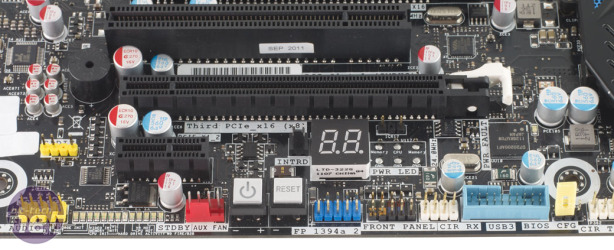
Performance
At stock speeds, the DX79SI proved just as capable as the other LGA2011 boards we've tested. Its score of 1,735 in the image editing test was top of the class, as was its SATA 6Gbps read speed of 553MB/sec. It also managed a SATA 6Gbps write speed of 521MB/sec, essentially maxing out our OCZ Vertex 3 SSD.The SATA 3Gbps ports are also fast enough to push older SSDs such as OCZ’s Vertex to their limits; the DX79SI managed a read speed of 279MB/sec and write speed of 280MB/sec on its SATA 3Gbps ports. You’ll need to make use of the SATA 6Gbps ports (coloured blue) to provide enough throughput for modern SSDs, though.
It was a fair bit slower than other boards in the HandBrake H.264 video encoding test, however. Its score of 3,530 is some way off the fastest boards we've seen. This resulted in an overall score of 2,252 for the DX79SI - the lowest we've seen from an LGA2011 board – but thanks to good results in the other two tests, this was only 59 points short of the ASRock X79 Extreme4-M, which managed 2,311. Meanwhile, our Arma II game test showed very little variation in results, with just 2fps separating the minimum frame rates of all the boards at stock speed.
We then headed into the EFI to see how far we could push our CPU. It was fairly easy to navigate but not as snappy as those from Asus and ASRock. However, it has the full range of tweakable options you’d expect for an LGA2011 motherboard, such as System Agent voltage adjustment and the ability to adjust the CPU straps to 1.00x, 1.25x or 1.67x. This allows for CPU Base Clock speeds in excess of 120MHz without the other bus speeds throwing their toys out of the pram.
Aiming for the CPU frequency of 4.7GHz that we’ve seen on most other boards proved fruitless, though, as anything higher than a CPU Base Clock of 121.65MHz using a 38x CPU multiplier resulted in Windows freezing, no matter what voltages we used. In the end we resorted to increasing the Turbo Boost Short Power MAX and Turbo Boost Max settings to 220W and settled on a vcore of 1.4V, a System Agent voltage of 1.005V and opted for the 1.25x CPU strap. Along with a CPU Base Clock frequency of 121.65MHz, this meant the System Base Clock was running at 97.32MHz, with an overall CPU frequency of 4.6GHz.
Click to enlarge
The Windows-based tweaking software proved fairly capable at tweaking the CPU multiplier and CPU Base Clock by small amounts, and provided real-time information on the various clock speeds and straps. However, it doesn’t offer as much potential for system tuning as Asus’ AI Suite and Thermal Radar utilities.
Our tweaking resulted in some sizeable performance gains, although with the smallest overclock of the seven boards we've tested so far, it wasn’t surprising to see the DX79SI return the lowest results. In our Media Benchmarks, its overall score rose to 2,848 from 2,252, while the minimum frame rate in Arma II rose to 85fps – a 5 per cent improvement.
Conclusion
The DX79SI is one of the better enthusiast-orientated motherboards we’ve seen from Intel and it surprised us with its looks and features. Many of these, such as the power and reset buttons and POST code readout, are absent from more expensive boards.
However, it’s also lacking in a few key areas, namely in its ability to overclock as easily as other LGA2011 boards, and when it comes to motherboard cooling. Asus’ Sabertooth X79 has much better cooling and sports the superb Thermal Radar tweaking suite. Given that the Sabertooth X79 costs just £17 more, this is money well spent as far as we’re concerned.
-
Value18 / 25
-
Features18 / 30
-
Speed40 / 45


MSI MPG Velox 100R Chassis Review
October 14 2021 | 15:04









Want to comment? Please log in.